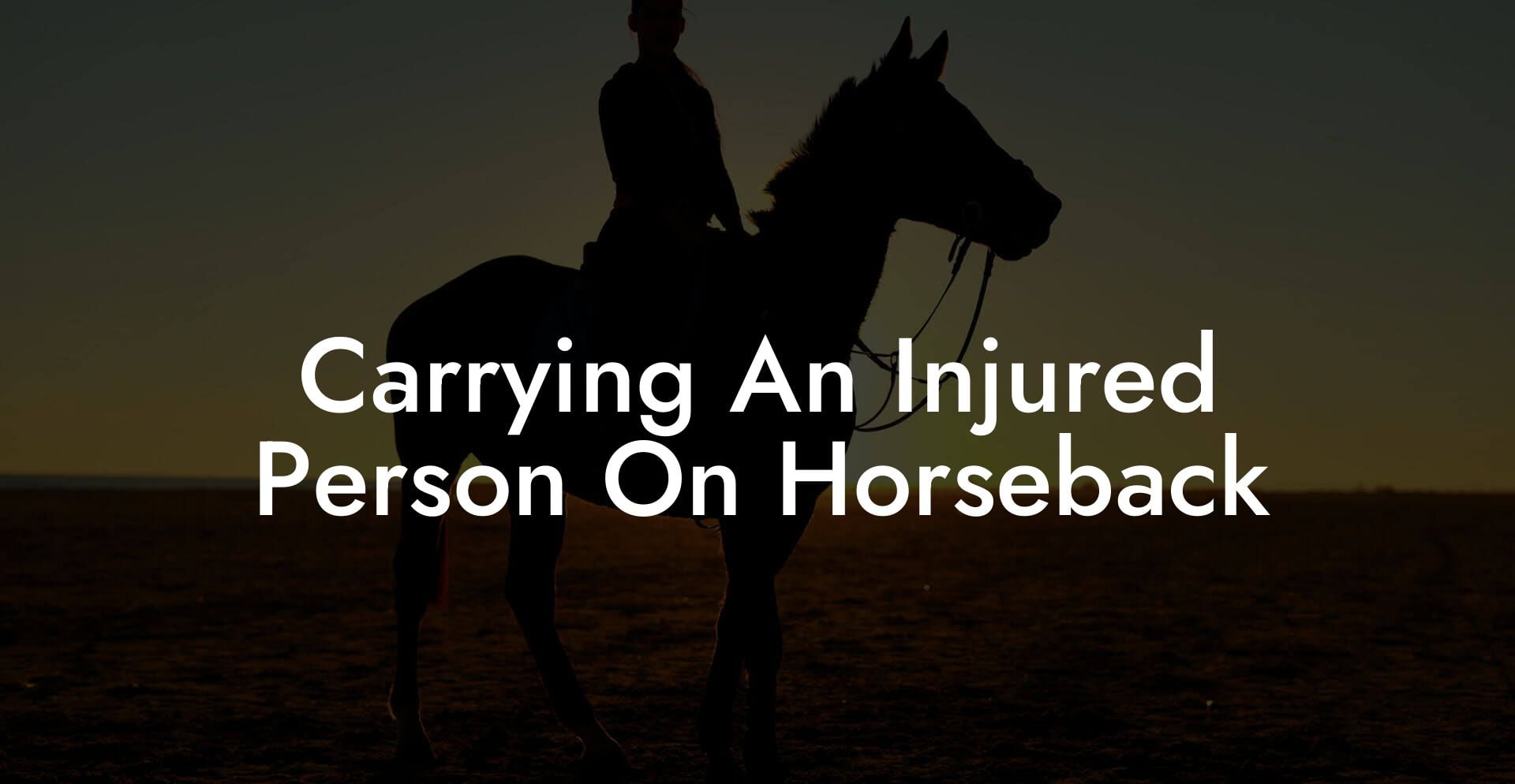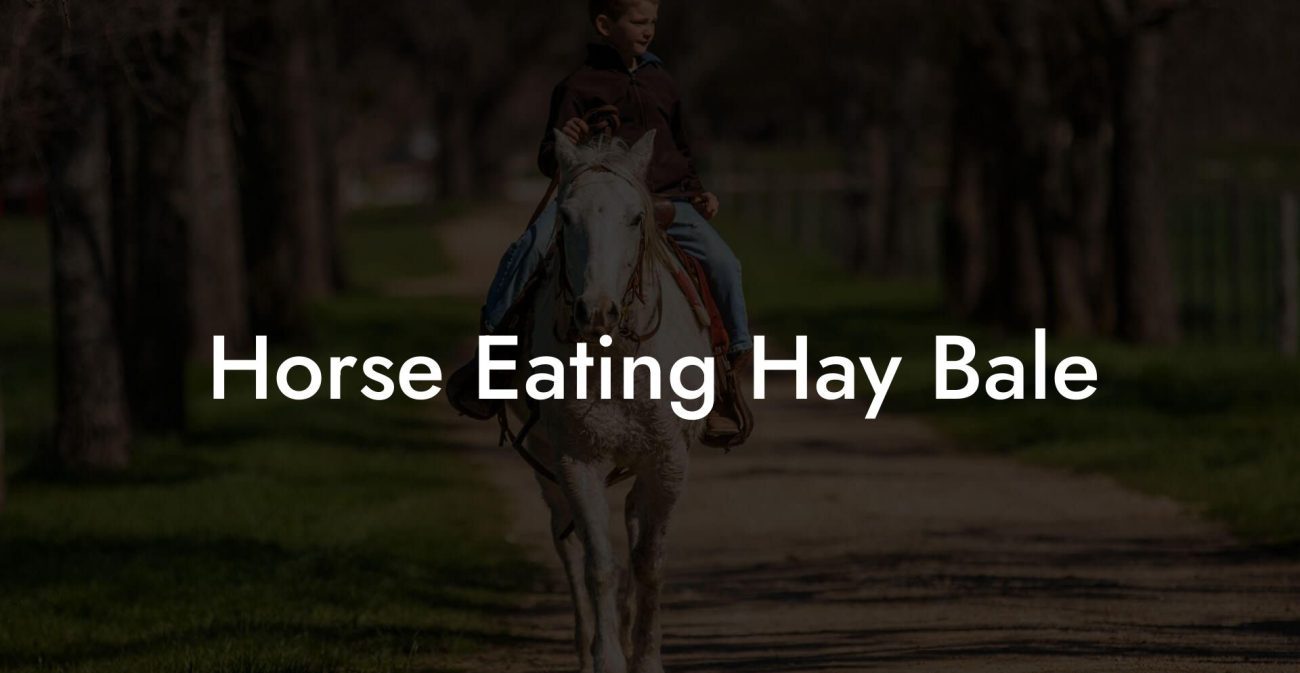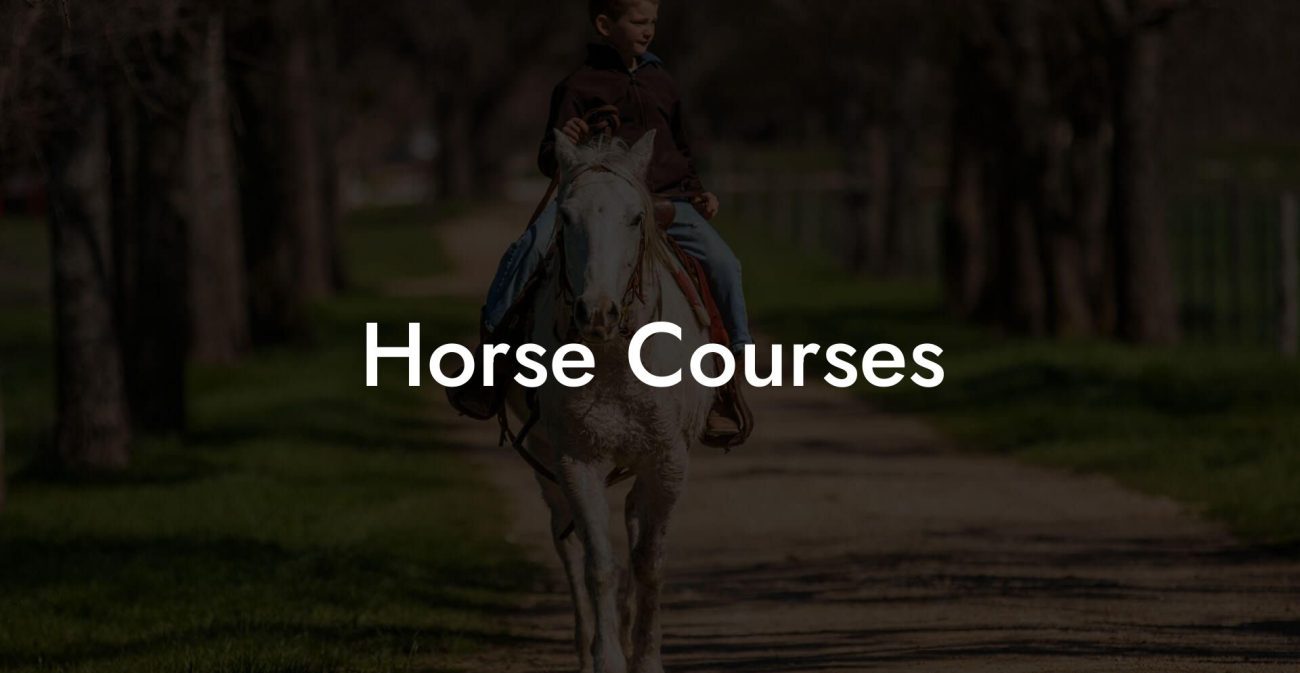Ever found yourself in a wild scenario where every second counts, and your trusty steed is the only backup you have? Picture a daring equestrian rescue mission where you need to carry an injured person on horseback, not the usual Sunday trail ride tale, but a high-stakes emergency that blends adrenaline, compassion, and a deep respect for your majestic horse’s abilities. In this ultimate guide, we’re diving head-first into the art and science of carrying an injured person on horseback, where equine care meets life-saving rescue techniques with a twist of modern, Gen-Z and millennial flair. Buckle up (or rather, saddle up) as we explore everything from the basics of equestrian emergency protocols to indispensable safety precautions, all while keeping it real with humor, heart, and a healthy dose of practicality.
Quick Links to Useful Sections
- Understanding the Basics of Horseback Rescue and Care
- When and Why Carrying an Injured Person on Horseback Makes Sense
- Preparing for the Unthinkable: training and equipment Essentials
- Equestrian First Aid and Rescue Training
- Critical Equipment: From Saddles to Stretchers
- Preparing Your Horse for Emergency Scenarios
- Carrying Techniques: Step-by-Step Methods for a Safe and Effective Rescue
- Step 1: Assess the Situation Quickly
- Step 2: Secure the Injured Person
- Step 3: Mounting the Horse with the Injured Person
- Step 4: Navigating Rough Terrain with Care
- Step 5: Transitioning on and Off the Horse
- Safety Precautions and Best Practices for Equestrian Rescues
- Post-Rescue Care: Ensuring a Smooth Recovery for Both Rider and Horse
- Immediate Post-Rescue First Aid
- Equine Aftercare
- Documenting the Incident
- Learning Through Practice: Simulations and Community Drills
- Resources and Community Support: Your Next Steps
- Real-Life Rescue Stories: Learning from Experience
- Case Study 1: A Mountain Mishap with a Miraculous Rescue
- Case Study 2: Urban Riding Meets Remote Rescue
- Case Study 3: Overcoming the Odds with Calm and Precision
- FAQs: Your Questions on Carrying an Injured Person on Horseback Answered
- Your Journey into Empowered Equestrian Rescue
Understanding the Basics of Horseback Rescue and Care
When it comes to emergency rescue on horseback, the stakes are high and the details matter. Combining equestrian know-how with tactical first aid isn’t just about making a dramatic movie scene, it’s a seriously valuable skill set for anyone working in rural emergency response, trail riding groups, or even adventure sports enthusiasts. By integrating comprehensive equine care with critical rescue techniques, you’re not only safeguarding your injured companion but also ensuring your horse is ready and able to perform in stressful scenarios.
At its core, carrying an injured person on horseback involves striking a delicate balance between two separate but interconnected worlds: the well-being of your injured rider and the physical and mental stress imposed on your horse. The rescue protocols we discuss here will cover everything from proper mounting techniques to keeping your horse calm and focused.
Key semantic keywords to keep in mind include "equestrian rescue techniques," "emergency equine first aid," "horseback rescue methods," and "saddle safety for emergencies." These cornerstone concepts ensure that whether you’re an experienced equestrian or just a curious adventurer, you’re in the right place to learn life-saving skills.
When and Why Carrying an Injured Person on Horseback Makes Sense
Let’s face it: emergencies don’t wait for the perfect moment, and neither do we. There are countless scenarios where traditional vehicular transport isn’t available, or the terrain makes it nearly impossible to reach the injured party quickly. Whether you’re trekking through rugged mountains, navigating dense forests, or exploring remote backcountry trails, there may come a time when your horse becomes your only means to get help.
Consider these situations as real-life case studies:
- Remote Trail Accidents: While riding through a secluded trail, an unexpected fall leaves a fellow rider injured and unable to walk. With no cellphone reception or immediate help in sight, your horse must become the ride-and-rescue vehicle.
- Emergency Medical Transport: In rural areas where ambulance response times can be excruciatingly slow, properly trained equestrians can provide immediate evac support, bridging the gap until further help arrives.
- Equine Assisted Therapy Gone Rogue: Sometimes, recreational activities can turn into emergencies unexpectedly. Your preparedness for carrying an injured person might just be the difference between a quick recovery and a prolonged crisis.
In every scenario, the balancing act between your own safety, the injured person’s well-being, and your horse’s welfare is paramount. Each decision made under pressure should factor in the capabilities and limitations of both human and animal, ensuring that each step of the rescue process is both safe and effective.
Preparing for the Unthinkable: training and equipment Essentials
Preparation is the name of the game when it comes to emergency rescues on horseback. The best equestrians know that success isn’t just about raw courage, it’s about having the right training, mindset, and gear to tackle unexpected challenges. Here’s an in-depth look at what you need:
Equestrian First Aid and Rescue Training
Before venturing into any dangerous terrain, it’s vital to equip yourself with specialized training. Look for courses in equestrian first aid, wilderness rescue, and backcountry emergency response. These classes teach you practical skills such as assessing injuries, stabilizing patients, and even basic veterinary care to keep your horse performing at its best during and after a rescue operation.
Modern training programs often merge traditional methods with technology, think simulated rescue scenarios using virtual reality, to help you feel confident when the real thing happens. Plus, these sessions can introduce you to innovative techniques, from using improvised stretchers to practical mounting drills tailored to emergency situations.
Critical Equipment: From Saddles to Stretchers
A well-equipped saddlebags pack more than just snacks and extra boots. When planning for rescue scenarios, consider carrying:
- Rescue Saddle Attachment: Special saddles designed for rescue operations feature quick-release mechanisms and additional support, helping you secure an injured person during transport.
- Adjustable Rescue Stretchers: Lightweight, portable stretchers can be easily attached to your horse’s back, creating a stable platform for injured riders who cannot sit upright. Their design must ensure comfort for the patient while not compromising the horse’s balance.
- Emergency Bridle and Halter Adjustments: Innovative bridging devices can ensure that your horse remains calm and responsive during the rescue, even in chaotic situations.
- Compact First Aid Kits: A dedicated kit, including bandages, tourniquets, and splints, allows you to stabilize the injured party before or during transport.
The right equipment not only aids the rescue but minimizes the risk of additional injuries. Remember: every piece of gear should be lightweight yet durable, ensuring seamless integration with your normal riding apparatus.
Preparing Your Horse for Emergency Scenarios
A rescue operation can be a stressful experience for your horse, so training your equine partner to remain calm under pressure is crucial. Desensitization exercises, where your horse is gradually exposed to unfamiliar stimuli like loud noises, sudden movements, or the awkward feel of a stretcher, can make all the difference.
Conditioning your horse through controlled practice sessions where they simulate carrying additional weight, or transitioning from a normal ride to an emergency posture, enhances their readiness. Positive reinforcement methods, such as treats or soothing pats, encourage your horse to associate these unusual situations with positive outcomes.
By investing time into both human and equine training, you'll create a dynamic rescue team ready to handle the unpredictable challenges that come with carrying an injured person on horseback.
Carrying Techniques: Step-by-Step Methods for a Safe and Effective Rescue
Now that you’ve got the basics in place, from training to equipment, let’s roll up our sleeves and get into the nitty-gritty of the rescue itself. Whether you’re a seasoned rider or a newbie stepping into the world of equestrian rescue, mastering these techniques is non-negotiable.
Step 1: Assess the Situation Quickly
In any emergency, seconds matter. The first order of business is to quickly assess the condition of the injured person and the environment. Is the accident site stable? Are there any external hazards like falling debris or uneven terrain? Your evaluation should encompass:
- Checking the injured person’s responsiveness and breathing.
- Noting any spinal or limb injuries.
- Observing environmental hazards that may affect the rescue.
A calm, clear-headed assessment ensures that your next steps are measured and appropriate for both the patient and your horse.
Step 2: Secure the Injured Person
Once you’ve gauged the situation, your next priority is ensuring the injured person is securely immobilized. If they’re conscious and responsive, provide reassurance and brief instructions. For those with suspected spinal injuries, caution is critical, avoid any unnecessary movements.
Using an adjustable rescue stretcher or a specially designed rescue saddle attachment, gently transfer the injured person onto the equipment. Here, teamwork is key: if another person is present, delegate roles so that one can stabilize the injured individual while you prepare the rescue gear.
Step 3: Mounting the Horse with the Injured Person
Mounting the horse under these conditions might feel like rocket science, but with practice, it becomes second nature. Here’s how:
- Secure the Restraint: Fasten the injured person onto the rescue device. Verify that all straps, buckles, and supports are secure. The goal is to prevent any further movement that could worsen their condition.
- Approach Calmly: Lead your horse to a safe, level area. Speak in soothing tones to keep the animal relaxed, as any sign of distress can throw off both the comfort of the patient and your own concentration.
- Quick-Release Mounting: Using techniques honed during training, mount the horse while simultaneously ensuring that the injured person is stable. Rely on saddle adjustments and straps that let you maintain balance while keeping the patient secure.
- Test Stability: Once mounted, gently test for any movement. A slight adjustment to the horse’s footing or the rigging might be required to guarantee smooth transport.
Mastering this technique takes practice. Simulated drills, carried out in controlled conditions, can help build muscle memory and boost your confidence for real-world emergencies.
Step 4: Navigating Rough Terrain with Care
With the injured person safely on board, the next hurdle is trajectory. Navigating rough terrain on horseback is an art in itself, and doing so while carrying additional weight requires a delicate mix of speed, caution, and clear-headed navigation. Here are some pointers:
- Slow and Steady Wins the Race: Avoid sudden movements and maintain a pace that keeps the load stable. Think of it like riding a roller coaster, but without the loops and with a much more serious passenger.
- Anticipate Obstacles: Scan the path ahead for obstacles such as rocks, streams, or steep inclines. Communicate with your horse using gentle reins and voice commands, signaling upcoming turns or stops.
- Maintain Balance: Constantly adjust your body position to aid your horse’s balance. Small corrections can prevent big mishaps when traversing uneven ground.
- Keep Focused: Any distraction could compromise safety. Rely on your training and your horse’s instinct to navigate through the most challenging parts of the journey.
These techniques aren’t just about reaching the destination, they’re about doing so while keeping both the patient and your horse in as safe a state as possible.
Step 5: Transitioning on and Off the Horse
The journey isn’t over once you reach a safe zone. The transition from the horse back to solid ground must be as well-executed as the rescue itself. Prepare a designated landing area that’s flat and secure, and coordinate the dismount process:
- Prepare the Landing Zone: Ensure the area is free of obstructions and has plenty of space for both the injured person and your horse.
- Dismount in Unison: With assistance if necessary, carefully dismount while keeping the injured party secured. Use slow, deliberate movements to avoid any jarring impacts.
- Provide Immediate Care: Once off the horse, quickly attend to any immediate medical needs before moving the injured person further. Stabilize them for further transport to a medical facility.
This final phase of the rescue is as crucial as the initial steps and requires you to be as calm and coordinated as possible.
Safety Precautions and Best Practices for Equestrian Rescues
Safety is paramount when attempting any rescue, especially when balancing the welfare of an injured person and a live animal. Here’s a robust list of safety precautions and best practices:
- Always Wear Protective Gear: Helmets, appropriate riding boots, and sturdy clothing can reduce injury risks during sudden maneuvers or falls.
- Establish Clear Communication: Develop non-verbal cues with your horse through consistent training and simple voice commands to minimize confusion in an emergency.
- Practice Regular Drills: Regularly simulate rescue scenarios in varying conditions. This not only builds confidence but also exposes any weak points in your rescue technique.
- Monitor Your Horse’s Condition: Stress can take a toll on your horse. Post-rescue, ensure the animal is checked for injuries or undue fatigue and provide adequate care.
- Keep First Aid Knowledge Fresh: Refresh your training periodically, staying up-to-date on the latest techniques in both human and equine first aid.
- Know Your Limits: Understand both your own limitations and those of your horse. If a situation feels beyond your control, it might be best to stabilize the injured person and wait for backup.
These guidelines not only ensure a safer rescue but work to protect the long-term health of your horse, who is an irreplaceable partner in your equestrian adventures.
Post-Rescue Care: Ensuring a Smooth Recovery for Both Rider and Horse
The rescue mission doesn’t simply end when you reach safety; the post-rescue phase is critical for both the injured person and your equine companion. Once you’ve managed to navigate rough terrain and safely dismount, attention must turn to recovery and aftercare.
Immediate Post-Rescue First Aid
When the injured person is off the horse, the next step is immediate stabilization. Whether you’re a medically trained professional or an avid first aider, ensure you:
- Re-assess the injured person’s vital signs and level of consciousness.
- Administer necessary first aid, this might include immobilizing fractures, controlling bleeding, or providing CPR if required.
- Keep the patient calm and as still as possible until professional medical help arrives.
Quick, efficient post-rescue care can significantly reduce long-term complications, so don’t skip these vital steps just because the adrenaline rush has faded.
Equine Aftercare
Your horse, having just carried a heavy responsibility, needs attention too. Post-rescue, make sure to:
- Cool Down Gradually: Allow your horse to walk slowly for a short period post-rescue, helping calm its muscles and prevent stiffness or injury after the exertion.
- Hydrate and Feed: Ensure your horse gets plenty of water and a light meal to replenish lost energy. A well-fed, hydrated horse recovers much faster.
- Monitor for Stress or Injury: Look for signs of fatigue, lameness, or behavioral changes. If anything seems off, contact a veterinarian promptly.
- Give Them a Break: Just like you would after a strenuous workout, allow your horse some downtime to recover mentally and physically from the high-pressure situation.
Caring for your horse after a rescue not only ensures its long-term health but also reinforces the bond between you and your equine partner, a bond that is crucial for any future emergencies.
Documenting the Incident
As modern rescuers know, documentation is key. Keep detailed records of the rescue, what equipment was used, the sequence of events, and any unexpected challenges. This documentation can serve as both a valuable learning tool for refining future protocols and as evidence, if ever required for insurance or legal matters. In the digital age, even a quick video recorded on your smartphone (when safe to do so) can become an essential part of the aftercare process.
Learning Through Practice: Simulations and Community Drills
While theoretical knowledge forms the backbone of any rescue technique, nothing beats hands-on practice. Training drills and simulations not only sharpen your skills but also help you gauge the cohesiveness of your team, both human and equine.
Simulated Drills: Arrange regular practice sessions where you simulate various rescue scenarios. Vary the conditions: different weather, terrain, and injury types. These drills secure the muscle memory necessary for a seamless operation when an actual emergency arises.
Collaborate with Experienced Riders: Reach out to local equestrian clubs, mountain rescue groups, or even adventure sports communities that specialize in off-road rescues. Learning from experienced professionals and gaining feedback can significantly elevate your rescue proficiency.
Community Workshops: Consider hosting or attending workshops on horseback rescue techniques. These sessions foster a supportive environment where you can share insights, learn new methods, and even network with like-minded riders who value the blend of equine care and emergency response.
Remember, every drill is an opportunity to refine your techniques, enhance your confidence, and ultimately save lives while keeping your beloved horse protected.
Resources and Community Support: Your Next Steps
The journey to mastering horseback emergency rescues is one you don’t need to travel alone. There’s a wealth of resources out there, from online courses, expert-led webinars, to community clubs that focus specifically on equestrian rescue techniques.
Get involved in local workshops and certification programs that emphasize both equine and human first aid training. Platforms like social media groups, YouTube tutorials, and dedicated websites for wilderness rescue can provide not only technical insights but also real-life success stories from fellow riders.
Explore partnerships with local fire departments or search-and-rescue teams, which occasionally offer training sessions tailored to rescuers operating in remote or rural areas. These collaborations not only enrich your skill set but also build a network you can rely on when the unexpected happens.
Ultimately, taking proactive steps in your training builds more than just competence, it builds community and trust, both of which are essential to navigating the high-stress situations that these rescues entail.
Real-Life Rescue Stories: Learning from Experience
The theory behind carrying an injured person on horseback becomes dramatically real when you hear stories from those who have lived it. Let’s dive into a few real-life rescue accounts that underscore the importance of preparedness and ingenuity.
Case Study 1: A Mountain Mishap with a Miraculous Rescue
In the rugged trails of a remote mountain range, a group of riders encountered an unexpected rockslide that left one individual with a broken leg. With no immediate ground support available, one rider, trained in equestrian rescue techniques, secured the injured person using a purpose-built rescue saddle and improvised stretchers. Through careful coordination, the team managed to traverse rocky paths and steep inclines until they reached a safe clearing where medical professionals could take over. This harrowing yet inspiring account highlights how critical quick thinking, proper equipment, and practiced techniques are in ensuring a positive outcome.
Case Study 2: Urban Riding Meets Remote Rescue
In a surprising twist, a rider from a bustling urban equestrian center found themselves on a remote trail when an unexpected accident left a fellow rider unconscious after a fall. With cell service out and time running short, the rider’s background training in equine rescue became the linchpin in a successful evacuation. Working in tandem with nearby rescue volunteers, they quickly stabilized the patient using techniques honed through repeated drills. The incident not only reaffirmed the merits of comprehensive training but also showcased the power of community and connectivity among urban and rural riders alike.
Case Study 3: Overcoming the Odds with Calm and Precision
During a lengthy trail ride through unpredictable weather, a sudden slip resulted in a rider landing awkwardly and sustaining a head injury. The lead rider, leveraging years of experience and a meticulously maintained rescue kit, managed to stabilize the injured party on a custom rescue mount. Through deliberate, calm instructions and precise execution, they navigated treacherous river crossings and steep declines, ensuring the patient reached a safety zone with minimal additional trauma. This case stands as a testament to the power of clear-headed decision-making under pressure and the vital importance of continuous, rigorous training.
These stories are a reminder that every rescue is a unique challenge. They reinforce the idea that with the right combination of knowledge, skills, and community support, even the most dire emergencies can be transformed into stories of hope and recovery.
FAQs: Your Questions on Carrying an Injured Person on Horseback Answered
Below are some frequently asked questions addressing common concerns about equestrian rescue techniques, emergency protocols, and horse care during these critical moments.
1. In what situations is carrying an injured person on horseback recommended?
It is recommended when traditional transportation is unavailable, particularly in remote, rugged terrains where rapid evacuation is essential and your horse is adequately trained for rescue scenarios.
2. What essential equipment should I always have ready for an equestrian rescue?
A rescue saddle or stretcher attachment, adjustable straps or harnesses, a comprehensive first aid kit for both human and equine use, and specialized bridle equipment to keep your horse calm are all critical tools for a safe rescue.
3. How do I ensure my horse is prepared for carrying extra weight in an emergency?
Regular training sessions, desensitization exercises, and conditioning drills help build your horse’s endurance. Incorporating simulated rescue scenarios into your training routine keeps your horse accustomed to handling additional loads.
4. Are there any risks associated with these rescue operations?
Yes, risks include further injury to the patient, undue stress or injury to the horse, and unstable terrain challenges. That’s why comprehensive training, proper equipment, and clear communication are crucial.
5. What role does teamwork play in a successful equestrian rescue?
Teamwork is indispensable. Coordinating with other riders or rescuers not only expedites the process but also reduces errors, providing backup and ensuring both the patient and the horse are kept safe.
6. How often should equestrian rescue drills be conducted?
Regular drills, at least twice a year or more, are recommended. This frequency helps ensure that both you and your horse remain comfortable with the procedures and that any equipment is in proper working order.
7. Can a beginner learn these rescue techniques, or are they reserved for experienced riders only?
While prior riding experience is beneficial, rescue techniques can be learned at any level through structured training programs specifically designed for both beginners and seasoned equestrians.
8. What should I do if I suspect my horse is stressed during a rescue operation?
If you notice signs of stress such as rapid breathing, sweating, or erratic behavior, ease off on the pace, use calming techniques, and, if necessary, pause the rescue until your horse can relax.
Your Journey into Empowered Equestrian Rescue
Mastering the art of carrying an injured person on horseback is more than just a dramatic stunt, it’s a commitment to safety, preparedness, and the well-being of everyone involved. This comprehensive guide is a testament to the evolving landscape of equestrian emergency response, where traditional horsemanship meets modern rescue techniques and state-of-the-art equipment.
As you embark on your journey to become proficient in these life-saving techniques, remember that you are not only refining your own abilities but also strengthening the trust and bond shared with your horse. Each drill, every training session, and all the sleepless nights spent studying rescue protocols are investments in a future where you’re prepared for the unexpected.
Whether you’re responding to a remote trail emergency or simply enhancing your riding skills, the knowledge shared here is meant to empower you to act confidently and decisively. Embrace the challenges with a sense of humor, a spirit of adventure, and the determination to protect and care for both your fellow riders and the loyal animal that carries you through life’s journeys.
Your journey into empowered equestrian rescue is a remarkable blend of human ingenuity, equine grace, and compassionate care. Use this guide as your playbook, a living resource that evolves with every experience, every lesson learned from the field, and every success story from your community. Here’s to riding boldly into action, armed with the skills, confidence, and heart needed for every rescue mission that comes your way!













